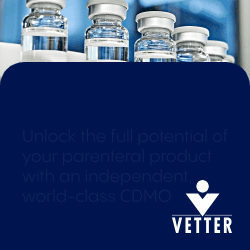Bio Platforms
Monarch Therapeutics & SNAP Biosciences Enter Licensing Agreement to Bolster Cell Therapy in Oncology
SNAP Biosciences, Inc., a majority-owned subsidiary of Coeptis Therapeutics Holdings Inc., and Monarch Therapeutics Inc. recently announced a licensing agreement to enable the development and…
XOMA Royalty Purchases Mezagitamab Royalty & Milestone Rights Held by BioInvent International for up to $30 Million
XOMA Royalty Corporation and BioInvent International AB recently announced XOMA Royalty has purchased the future mezagitamab (TAK-079) royalty and milestone interests held by BioInvent for…
Altamira Therapeutics Announces Collaboration on Circular RNA Delivery
Altamira Therapeutics Ltd. recently announced it has entered into a collaboration agreement with an undisclosed company to evaluate the potential use of Altamira’s proprietary CycloPhore…
IMUNON Announces Oral Presentation Highlighting Unprecedented Survival Data From Phase 2 Trial of IMNN-001 in Treatment of Newly Diagnosed Advanced Ovarian Cancer
IMUNON recently announced new positive data from its Phase 2 OVATION 2 Study of IMNN-001, an investigational therapy for the treatment of advanced ovarian cancer.…
Amphista Therapeutics Showcases Cryo-EM Enabled Platform for Discovering Novel Targeted Glue Degraders
Amphista Therapeutics presented its unique approach to constructing novel, orally bioavailable Targeted Glue protein degraders with mechanisms of action (MoA) distinct from traditional CRBN/VHL approaches…
Belite Bio Announces Breakthrough Therapy Designation for Tinlarebant for the Treatment of Stargardt Disease
Belite Bio, Inc. recently announced the US FDA has granted Breakthrough Therapy Designation for Tinlarebant for the treatment of Stargardt disease (STGD1) based on the…
Kaida BioPharma Announces New Partnership With Northway Biotech for the Manufacturing of KAD101
Kaida BioPharma recently announced it has entered into a manufacturing agreement with Northway Biotech, Inc. for the manufacturing of lead product candidate, KAD101. Under the…
Montara Therapeutics to Develop Novel Treatments Using the BrainOnly Platform
Montara Therapeutics recently announced it has received a research grant from The Michael J. Fox Foundation for Parkinson’s Research (MJFF) in addition to joining MJFF’s…
Philikos Announces Initiation of Clinical Phase 1/2 Study With T-Guard in Patients With Systemic Sclerosis
Philikos B.V. recently announced it has enrolled the first patient in a Phase 1/2 clinical trial designed to evaluate the use of T-Guard for the…
GT Biopharma Advances GTB-3650 Phase 1 Trial to Cohort 2 Following Successful Initial Human Dosing & Evidence of Early Immune Activation Signals
GT Biopharma, Inc. recently announced successful completion of dosing in Cohort 1 and subsequent initiation of dosing in Cohort 2 of its Phase 1 dose escalation…
Fujifilm Validates Cancer Cell-Targeting Potential of Peptide Oligonucleotide Conjugates With Novel Cyclic Peptides
FUJIFILM Corporation announces the successful validation of the cancer cell-targeting potential of its peptide-oligonucleotide conjugates. This validation resulted from combining oligonucleotides with cyclic peptides developed…
Prime Medicine Announces Breakthrough Clinical Data Showing Rapid Restoration of DHR Positivity After Single Infusion of an Investigational Prime Editor for Chronic Granulomatous Disease
Prime Medicine, Inc. recently announced positive initial data from the first patient dosed in its ongoing Phase 1/2 clinical study of PM359 in Chronic Granulomatous…
Hovione & Firstgene Announce Strategic Collaboration to Advance Virus-Like Particle Platform for Liver Cancer
Hovione and Firstgene Life Sciences recently announced a strategic collaboration to advance Hovione’s proprietary virus-like particle drug delivery platform for the targeted treatment of Hepatocellular…
Septerna & Novo Nordisk to Collaborate on Oral Small Molecule Medicines for Obesity & Other Cardiometabolic Diseases
Septerna, Inc. and Novo Nordisk recently announced an exclusive global collaboration and license agreement to discover, develop, and commercialize oral small molecule medicines for obesity,…
IN8bio Presents Preclinical Data Highlighting Potential of INB-619 T Cell Engager for Autoimmune Disease
IN8bio, Inc. recently announced new preclinical data from its INB-619 program at the 2025 American Society of Gene & Cell Therapy (ASGCT) Annual Meeting. The data…
HCW Biologics Announces Positive Results of Studies of Proprietary Compound & Availability for Commercialization
HCW Biologics Inc. recently announced presentation of studies showing that its proprietary fusion protein, HCW9206, provides a new pathway for generating chimeric T-cell receptor -…
Alzamend Neuro Initiates First Phase 2 Trial of AL001 “Lithium in Brain” Study
Alzamend Neuro, Inc. recently today announced the initiation of the first of five Phase 2 clinical studies of AL001, with the first study in healthy…
Invivyd Announces New Pipeline Discovery Program Focused on Monoclonal Antibody Treatment for Measles
Invivyd, Inc. recently announced it has initiated a discovery program for a measles monoclonal antibody (mAb). Multiple healthcare providers (HCPs) who are treating active measles…
ABLi Therapeutics Launches With a Focus on Developing Treatments for Neurodegenerative Diseases that Arise from Activation of c-Abl Kinases
ABLi Therapeutics recently launched with the mission of developing its lead product candidate, Risvodetinib (ABLi-148009), as a potential disease-modifying therapy for Parkinson’s and Parkinson’s-related diseases…
Tiziana Life Sciences Announces Significant Reduction in Microglia Activation in PET Scan of Moderate Alzheimer's Patient Treated With Intranasal Foralumab
Tiziana Life Sciences, Ltd. recently announced results of a PET scan showing a marked reduction in microglia activation associated with neuroinflammation in a patient suffering from…
What are Bio Platforms?
Platforms (or asset-independent technologies to capture all kinds of capabilities that can be leveraged across many different drug candidate assets rather than just discovery tools that the term ‘platform’ immediately brings to mind) are ubiquitous in modern pharma. They are the product of an arms race, to secure access to the best capabilities in key areas.
Platform technologies are considered a valuable tool to improve efficiency and quality in drug product development. The basic idea is that a platform, in combination with a risk-based approach, is the most systematic method to leverage prior knowledge for a given new molecule. Furthermore, such a platform enables a continuous improvement by adding data for every new molecule developed by this approach, increasing the robustness of the platform.
But it has often been said that access to the latest technological platforms to aid efficient drug discovery and development is limited to Big Pharma, which can more easily justify the costs of creating and operating these platforms.
Benefits of Bio Platforms
Platform technologies have the ability to radically improve upon current products and generate completely novel products. In this sense, they open up new arenas for drug discovery and development, potentially increasing the number of therapeutic options for patients. Once a single compound or therapeutic has been generated and demonstrates a clinical benefit in patients, it is more likely this platform technology can successfully be applied to other therapeutic areas, derisking future compounds/products.
Complex drugs by their very nature are challenging and costly to manufacture. This, in turn, translates into higher costs for patients and other payers. In order to provide safe and effective therapies at a reasonable price, it is necessary for the industry to develop manufacturing technologies that reduce costs and provide a consistent product. While the initial investment may be larger, manufacturing costs will be lower over time as the manufacturing process is solidified.
Scale and Investment of Bio Platforms
Despite the initial upfront costs, platform technologies inevitably provide pragmatic solutions to production challenges, while yielding safer and more effective therapeutic products. It has often been said that one of the key features that distinguishes “Big Pharma” from biotech is access to the latest technological platforms to aid efficient drug discovery and development.
These platforms range from vast chemical libraries, ultra-high throughput screening and huge genetic databases in discovery, to predictive toxicology platforms, cutting-edge ‘omics’ and even deep-seated knowledge of particular therapeutic areas in development. All these platforms have two things in common: They can be used on any (or many) development candidate assets, and they cost huge sums to establish in the first place, and in a few cases each time they are used as well. Hence their restriction to the largest pharmaceutical companies (and a few of the so-called “big biotechs” that are, in many ways, indistinguishable from the old-guard pharma).
Only when you have hundreds of active projects can you justify the cost of creating and operating these platforms. Or so the mantra goes. It is access to these platforms that keeps the big companies ahead in the race to discover and develop the best medicines (or at least counterbalance the disadvantages of being large and slow-moving, depending on your point of view). But is that just an assertion? How much evidence is there to support the proposition that the efficiency gains due to these platforms outstrips the cost of creating and maintaining them?
Keeping these technologies “cutting edge” has become so expensive that increasingly we hear pharma companies talking of “pre-competitive” approaches to develop the next generation. A group of companies might develop a platform capability they then share. The principle goal of such initiatives is to access even grander and more expensive tools than individual companies could afford, rather than to dramatically cut costs (although sharing platforms rather than developing the same thing in parallel in each silo should at least keep a lid on rising costs).










